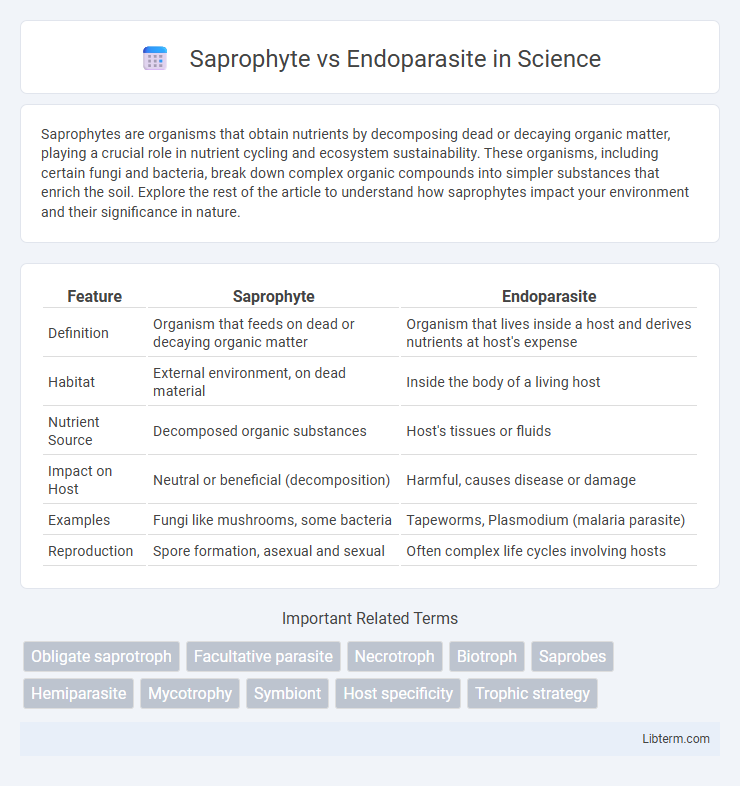Saprophytes are organisms that obtain nutrients by decomposing dead or decaying organic matter, playing a crucial role in nutrient cycling and ecosystem sustainability. These organisms, including certain fungi and bacteria, break down complex organic compounds into simpler substances that enrich the soil. Explore the rest of the article to understand how saprophytes impact your environment and their significance in nature.
Table of Comparison
| Feature | Saprophyte | Endoparasite |
|---|---|---|
| Definition | Organism that feeds on dead or decaying organic matter | Organism that lives inside a host and derives nutrients at host's expense |
| Habitat | External environment, on dead material | Inside the body of a living host |
| Nutrient Source | Decomposed organic substances | Host's tissues or fluids |
| Impact on Host | Neutral or beneficial (decomposition) | Harmful, causes disease or damage |
| Examples | Fungi like mushrooms, some bacteria | Tapeworms, Plasmodium (malaria parasite) |
| Reproduction | Spore formation, asexual and sexual | Often complex life cycles involving hosts |
Introduction to Saprophytes and Endoparasites
Saprophytes obtain nutrients by decomposing dead organic matter, playing a crucial role in nutrient cycling and ecosystem stability through the breakdown of complex substances into simpler compounds. Endoparasites live inside the host organism, deriving nourishment at the host's expense while often causing varying degrees of harm or disease. Both saprophytes and endoparasites demonstrate specialized adaptations for survival, with saprophytes thriving on external dead material and endoparasites adapting to internal environments within living hosts.
Definition of Saprophytes
Saprophytes are organisms that obtain nutrients by decomposing dead organic matter, playing a critical role in nutrient cycling within ecosystems. Unlike endoparasites, which live inside a host and derive sustenance at the host's expense, saprophytes thrive independently by breaking down complex organic compounds into simpler substances. Common saprophytes include fungi and certain bacteria that contribute to soil fertility through decomposition processes.
Definition of Endoparasites
Endoparasites are organisms that live inside the body of a host organism, obtaining nutrients at the host's expense and often causing harm. Unlike saprophytes, which feed on dead or decaying organic matter, endoparasites invade living hosts and can affect tissues, organs, or bodily fluids. Common examples of endoparasites include tapeworms, roundworms, and protozoa causing diseases like malaria.
Key Differences Between Saprophytes and Endoparasites
Saprophytes obtain nutrients by decomposing dead organic matter, playing a crucial role in nutrient cycling and ecosystem balance, whereas endoparasites live inside a host organism, deriving nourishment at the host's expense and often causing harm. Saprophytes typically have a free-living, non-harmful existence in soil, water, or decaying material, while endoparasites dwell within host tissues or cells, adapting specialized mechanisms to evade host defenses. Unlike saprophytes, endoparasites exhibit a parasitic relationship characterized by dependency on a living host for completion of their life cycle and reproduction.
Modes of Nutrition: Saprophytes vs Endoparasites
Saprophytes obtain nutrients by decomposing dead organic matter, secreting enzymes that break down complex substances into simpler compounds for absorption, playing a crucial role in nutrient cycling. Endoparasites derive nutrition directly from living host tissues or bodily fluids, often causing harm by exploiting the host's resources for growth and reproduction. The distinct modes of nutrition reflect saprophytes' ecological function in decomposition versus endoparasites' dependence on living hosts for sustenance.
Habitats and Ecological Roles
Saprophytes thrive in decaying organic matter, playing a crucial role in nutrient recycling by breaking down dead tissues and returning essential elements to the ecosystem. Endoparasites inhabit the internal tissues or organs of living hosts, often causing disease while deriving nutrients directly from the host's body. These contrasting habitats and ecological roles highlight saprophytes as decomposers maintaining ecosystem balance, whereas endoparasites influence host population dynamics and health.
Examples of Saprophytes
Saprophytes thrive on decomposing organic matter and include fungi such as mushrooms (Agaricus) and molds (Aspergillus), as well as certain bacteria like Bacillus species. These organisms play a crucial role in nutrient cycling by breaking down dead plants, animals, and waste. Unlike endoparasites, which live inside a host organism, saprophytes obtain nutrients externally from non-living organic material.
Examples of Endoparasites
Endoparasites are organisms that live inside their host's body, deriving nutrients at the host's expense, such as tapeworms (Taenia spp.), roundworms (Ascaris lumbricoides), and Plasmodium species causing malaria. These parasites inhabit various internal organs, including the intestines, bloodstream, or tissues, often causing diseases that affect the host's health. Unlike saprophytes, which feed on decaying organic matter externally, endoparasites maintain a close biological relationship within living hosts.
Environmental Impact and Importance
Saprophytes play a crucial role in ecosystems by decomposing dead organic matter, recycling nutrients, and maintaining soil health, which supports plant growth and biodiversity. Endoparasites impact environmental dynamics by influencing host population control and ecosystem balance, often affecting species interactions and energy flow. Both organisms contribute significantly to ecological stability, with saprophytes enhancing nutrient cycles and endoparasites shaping host community structures.
Conclusion: Saprophyte or Endoparasite – Which is More Beneficial?
Saprophytes play a crucial role in ecosystems by recycling nutrients through the decomposition of organic matter, promoting soil health and plant growth. Endoparasites, while often harmful to their hosts by extracting nutrients and causing diseases, can influence host population dynamics and ecosystem balance. Saprophytes are generally considered more beneficial due to their positive impact on nutrient cycling and environmental sustainability.
Saprophyte Infographic

 libterm.com
libterm.com